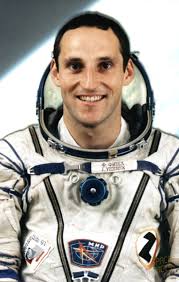Franz Viehböck
Austrian - (ALR)
Retired
Date of Birth: Aug. 24, 1960
Age: 65
Franz Artur Viehböck (born August 24, 1960 in Vienna) is an Austrian electrical engineer, and was Austria's first cosmonaut. He was titulated „Austronaut“ by his country's media. He visited the Mir space station in 1991 aboard Soyuz TM-13, returning aboard Soyuz TM-12 after spending just over a week in space.
Soyuz-U2 | Soyuz TM-12
Soviet Space Program | RussiaBaikonur Cosmodrome, Republic of Kazakhstan
May 18, 1991, 12:50 p.m.
Status: Success
Mission:
Soyuz TM-12 was the 12th mission and the ninth long-duration expedition to Mir space station. The mission began on May 18, 1991, 12:50:28 UTC, launching Commander Anatoly Artsebarsky, Flight Engineer Sergei Krikalyov and Research Cosmonaut Helen Sharman, the first British cosmonaut, into orbit. They docked with Mir two days later. During their stay there, cosmonauts performed EVAs, various station repair and maintenance tasks, and carried out scientific experiments in biology, geophysics, space technology, astronomy etc. They were visited by several Progress resupply spacecrafts and welcomed aboard the Soyuz TM-13 crew. Helen Sharman returned on May 26, 1991, in Soyuz TM-11 spacecraft. While Sergei Krikalyov stayed on the station as a part of the next long-duration expedition, Anatoly Artsebarsky landed safely back on Earth on October 10, 1991, 04:12:18 UTC.
Low Earth OrbitSoyuz-U2 | Soyuz TM-13
Soviet Space Program | RussiaBaikonur Cosmodrome, Republic of Kazakhstan
Oct. 2, 1991, 5:59 a.m.
Status: Success
Mission:
Soyuz TM-13 was the 13th mission and the tenth long-duration expedition to Mir space station. The mission began on October 2, 1991, 05:59:38 UTC, launching Commander Alexander Volkov, Research Cosmonaut/Flight Engineer Toktar Aubakirov and Research Cosmonaut Franz Viehböck, the first Austrian cosmonaut, into orbit. They docked with Mir two days later. During their stay there, cosmonauts performed EVAs, various station repair and maintenance tasks, and carried out scientific experiments in biology, geophysics, space technology, astronomy etc. They were visited by several Progress resupply spacecrafts, and welcomed aboard the Soyuz TM-14 crew. The mission concluded with a safe landing back on Earth on March 25, 1992, 08:51:22 UTC.
Low Earth OrbitThe Austrian Space Agency was founded in 1972 and joined the ESA as a member in 1987. In 2005, control of the ALR was transferred to the Austrian Agency for Aerospace. They coordinated the first flight of an Austrian in space with a Soyuz launch in 1990.
Falcon 9
Starlink Group 6-88
Space Launch Complex 40 - Cape Canaveral SFS, FL, USAA batch of 29 satellites for the Starlink mega-constellation - SpaceX's project for space-based Internet communication system.
Falcon 9
CSG-3
Space Launch Complex 4E - Vandenberg SFB, CA, USACSG-3 is an Earth observation satellite for the Italian Space Agency, part of a reconnaissance constellation using synthetic aperture radars operatin…
Long March 7A
Shijian 29 A-B
201 - Wenchang Space Launch Site, People's Republic of China2 satellites officially described as for "demonstration of new technologies for spatial targets detection" purposes.
Long March 4B
Tianhui 7
Launch Area 94 (SLS-2 / 603) - Jiuquan Satellite Launch Center, People's Republic of ChinaA satellite officially described as for cartography purposes, details TBD.
Soyuz 2.1b/Fregat-M
AIST-2T 01 & 02
Cosmodrome Site 1S - Vostochny Cosmodrome, Siberia, Russian FederationA pair of Russian optical Earth observation satellites built by the Progress Rocket Space Centre for obtaining stereo images of the Earth's surface, …



